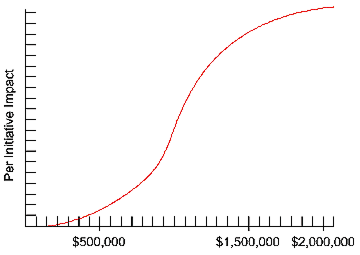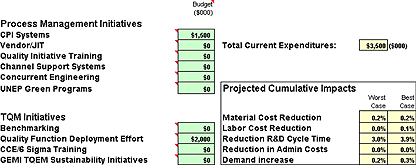TQM (Total Quality Management)/Sustainability initiatives can reduce material, labor and administrative costs, shorten the length of time required for R&D projects to complete and increase demand for the product line. The impacts of the investments produce returns in the year they are made and in each of the following years.
The two sustainability-oriented initiatives, the UNEP Green Program and GEMI TQEM, can lower labor and material costs. The UNEP Green Program also can improve customer perceptions about your company, which leads to increased sales. The remaining initiatives can also increase efficiency and lower costs.
Your company needs to determine which initiatives best serve its purposes. If you are keeping automation levels low so R&D projects complete more quickly, you might want to invest in areas that lower labor costs (for example, Quality Initiative Training). If your company is competing in the high technology segments, with high material costs, you might consider initiatives that reduce material costs (for example, Continuous Process Improvement). To maximize the effect, companies should find complementary initiatives and invest in each of them. For example, to reduce material costs, companies should consider investing in both CPI Systems and GEMI TQEM Sustainability.
After reviewing this section, test your knowledge by clicking TQM/Sust. Quiz to the left.
7.1.1 Process Management Initiatives
The impacts of these initiatives improve business procedures, resulting in improved efficiencies and cost structures::
- CPI (Continuous Process Improvement) Systems: Reduces material cost and to a lesser degree labor costs;
- Vendor/JIT (Just in Time [Inventory]): Reduces Material c osts and Administrative overhead;
- QIT (Quality Initiative Training): Reduces labor costs;
- Channel Support Systems: Increases the effectiveness of the sales budget, and therefore demand;
- Concurrent Engineering: Reduces R&D cycle time, the time n eeded to move sensors on the Perceptual Map and to change MTBF specifications. R&D costs are determined by the length of time they require, therefore Concurrent Engineering also lowers R&D costs;
- UNEP Green Program: The United Nations Environment Progr am increases the effectiveness of the sales budget (customers prefer products made by socially responsible manufacturers), and therefore increases demand. Green programs also reduce waste and therefore material costs.
7.1.2 TQM Initiatives
The impacts of these initiatives improve product quality while reducing the time and resources required to design, manufacture, warehouse and ship products.
- Benchmarking: Reduces Administrative overhead;
- Quality Function Deployment Effort: Reduces R&D cycle time and enhances the effectiveness of the Promotion and Sales Budgets;
- CCE (Concurrent Engineering)/6 Sigma Training: Reduces material costs and labor costs;
- GEMI TQEM Sustainability: The Global Environmental Management Initiative Total Quality Environmental Management initiative reduces labor costs as it minimizes environmental risks. These include production methods which protect employee health and redesign of products to have fewer toxic by-products. The initiative also reduces material costs, as it promotes recycling and other material use efficiencies.
7.1.3 S-Shaped Curve
For each initiative, returns for investments follow the shape of an S-curve (Figure 7.8). That is, if you spend too little or too much the returns on your investment are poor. If you spend less than $500,000 in any initiative in a single round chances are you will see little return. An investment of $1,500,000 in a single round produces a cost-effective impact, investments over $1,500,000 become dollar for dollar less effective. Finally, for each initiative, an investment over $2,000,000 in a single round produces absolutely no additional benefit.
For each impact, complementary initiatives combine together to increase the total effect. You should bundle your investments in multiple initiatives that have an impact important to your company’s strategy. By spreading your investment among complementary initiatives you can invest more in each impact than the limit of $2,000,000 for an individual initiative.
You can target multiple impacts, such as both material and labor cost reduction; this can be a substantial investment in any given year. As you fine tune your decisions, keep an eye on the Projected Cumulative Impacts to ensure that your investments are creating cost-effective returns.
Companies that invest in the same initiatives over two or three rounds (depending on the amount of money) will experience decreasing and eventually no additional returns for their investments.

Expenditures beyond $4,000,000 over two or three years in each initiative pushes well into diminishing returns.
For example, suppose a company wants to reduce the time required to complete R&D projects by investing in Concurrent Engineering and Quality Function Deployment. An aggressive schedule would be $1,500,000 this year (staying within acceptable diminishing returns); $1,500,000 next year (which would not produce as much benefit, but would continue to improve R&D cycle time); and $1,000,000 in the third year.
The TQM area displays the projected impacts for the current year. As companies make decisions, worst-case/best-case sets of outcomes are predicted. These are also carried into the proformas. The spreadsheet can only offer a range of possible savings. Actual results appear the following round on page 12 of The Capstone Courier in the HR/TQM Report.
Login to the Capstone Web Application and click the Decisions menu. Select TQM/Sustainability. Investments are entered in the green cells. Projected impacts also display.
